Everything You Need to Know About Cooking with Aluminum Foil
Explore the advantages of using aluminum foil and discover essential tips to remember when baking and cooking with aluminum foil.
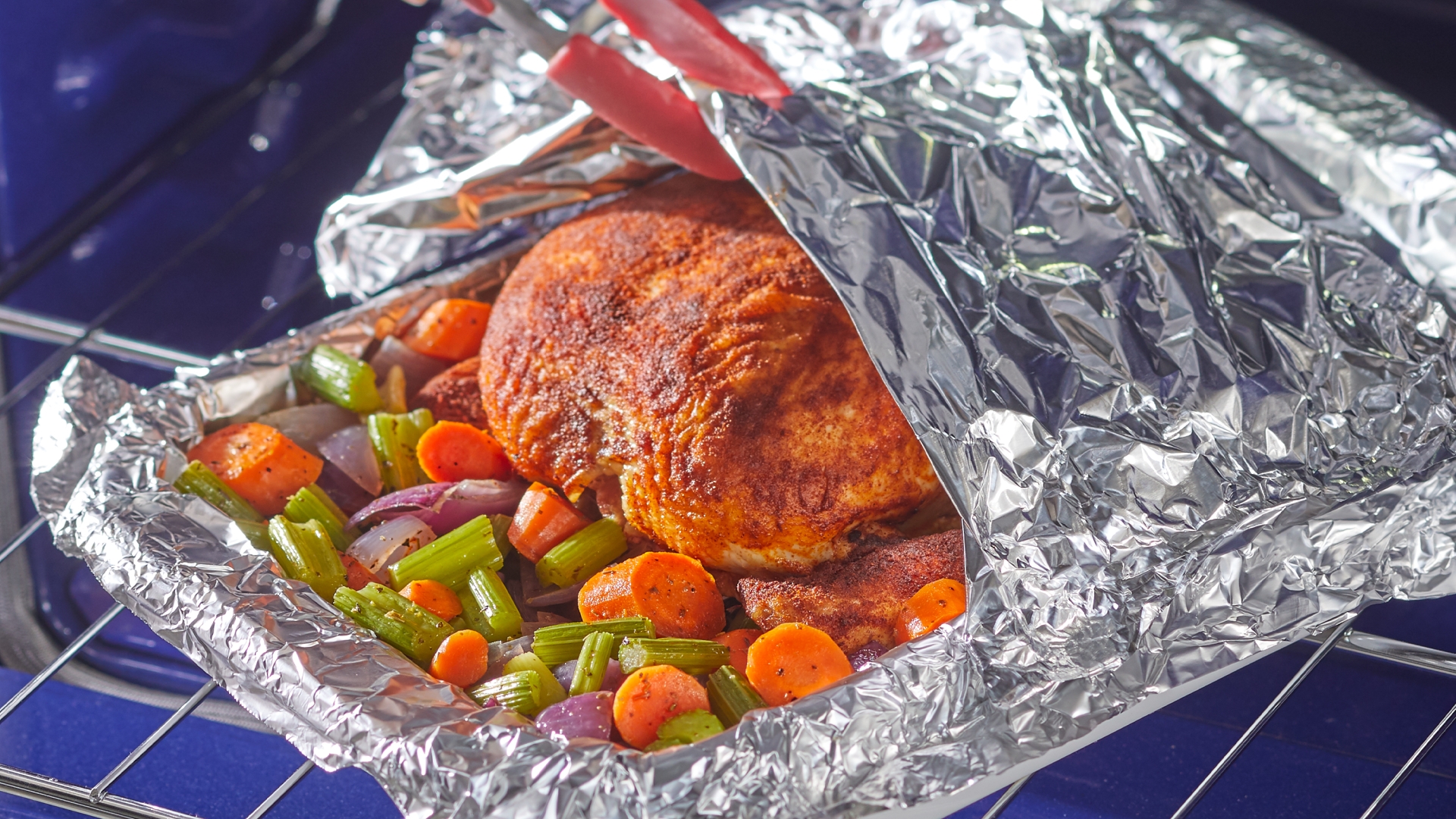
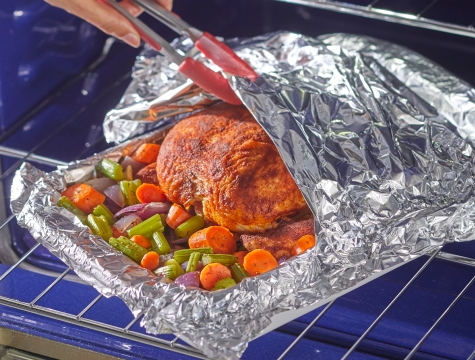
Cooking with Aluminum Foil
Is it Safe to Cook with Aluminum Foil?
For years, aluminum foil has been a reliable and trusted way of storing and cooking food. It does an excellent job of blocking light, air, and any harmful microbes that could lead to spoilage. Research conducted by the International Aluminum Institute shows that only minimal amounts of aluminum transfer from cookware and foil into food, making it safe for cooking and food storage.
Can Aluminum Foil Go in the Oven?
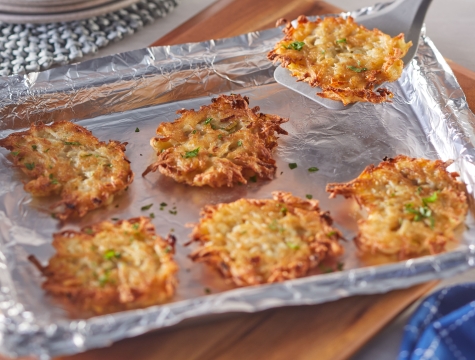
Lining baking sheets and pans
Save time and make cleanup simple with the convenience of lining pans with aluminum foil. Whether you prefer Reynolds Wrap® Everyday Foil or pre-cut Reynolds Wrap® Foil Sheets, you can easily line your sheet pans or create quick and tasty individual-serving foil packets for simple and delicious meals. Are you baking cheesy or sticky foods like macaroni and cheese or cinnamon rolls? We recommend using Reynolds Wrap® Non-Stick Foil made with a food-safe non-stick coating to prevent your food from sticking, so you can enjoy every bite.
When you need extra durability, reach for Reynolds Wrap® Heavy Duty Foil. It’s perfect for higher-heat cooking, such as lining broiler pans or making multiple serving-sized foil packets for the oven.
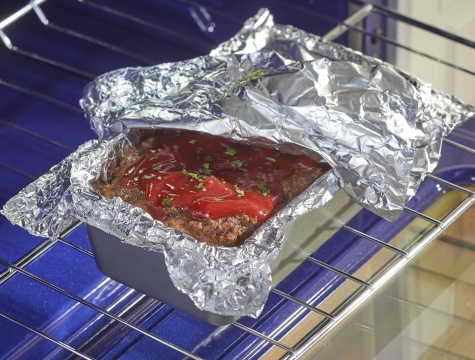
Covering dishes with aluminum foil
It’s always a great idea to cover your dishes with aluminum foil while cooking at high temperatures in the oven. It protects your food from drying out or burning and helps keep in the heat and moisture, ensuring a perfectly cooked meal. Loosely covering your dish with foil can prevent uneven browning while baking. However, tightly sealing your bakeware with foil is the way to go for more steam.
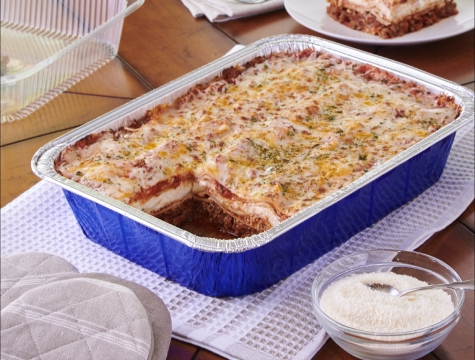
Baking in disposable aluminum bakeware pans
Disposable bakeware trays and pans are a versatile and practical option for cooking and baking. Aluminum pans can withstand high oven temperatures and evenly distribute heat, like aluminum foil. These containers are not only durable but also easy to transport and use. No matter what you’re baking or cooking, these containers can accommodate most of your needs. Ensure you lift and support pans with a non-disposable cookie sheet when taking in and out of the oven or transporting, especially if your dish is heavy. And, to top it off, cleaning up after is a breeze with these convenient and hassle-free containers.
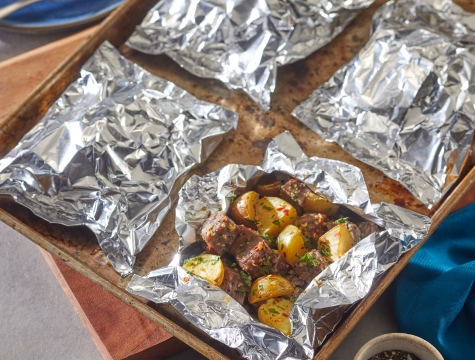
Wrapping foil packet dinners
Foil packet dinners are perfect for busy kitchens since they are easy to prepare, clean up, and make ahead of time while yielding delicious and juicy meals. They trap moisture and flavor, making cooking faster and more efficient. Plus, the versatility of different recipes and ingredients used in foil packet dinners makes them suitable for various tastes and dietary preferences.
Foil pack meals typically cook at 450°F, as the oven temperature must be high enough to penetrate the foil. You’ll need to lengthen the cooking time if you bake at a lower temperature.
Want simple pre-made meals for camping and outdoor adventures? Explore easy make-ahead foil pack meals for camping a perfect solution for families looking to streamline their camping routine without sacrificing flavor.
Prepping and warming food and leftovers
If you want a warm dinner fast, try using aluminum foil. Need to warm up some store-bought tortillas? Simply wrap them in foil and place them in the oven. Re-heat pizza in just a few short minutes by placing leftover slices on foil-lined baking sheet. Warm in the oven or toaster oven, then enjoy!
Lining your oven with aluminum foil
Don’t cover the entire rack with foil when lining an oven rack to catch spills. Instead, cover only an inch or two more than the pan, leaving room for airflow. Do not use aluminum foil to line the bottom of your oven. It can cause damage to the surface and heating elements, disrupt heat distribution, and lead to less-than-optimal cooking results. In fact, most oven manufacturers recommend you avoid using aluminum foil to line the bottom of your oven, as the high heat can cause the foil to melt and permanently damage your appliance. It’s best to rely on traditional oven cleaning methods.
Grilling with Aluminum Foil
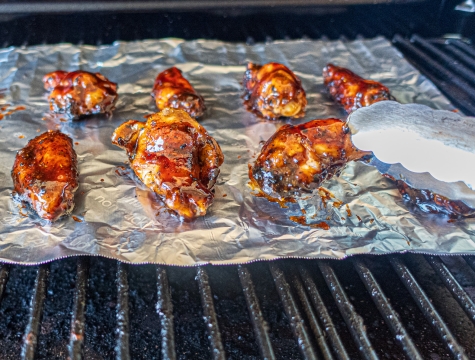
Grilling made easy with aluminum foil
Looking for the easiest way protect your food from sticking to the grill grate or falling through the cracks? Use Reynolds Wrap® Non-Stick Grill Foil to keep meats with sticky sauces from clinging to the grill and protect delicate foods like fish, shrimp, or vegetables from falling through the cracks. Aluminum foil allows you to savor all the deliciousness of your delicacies and save money from losing food pieces to the coals.
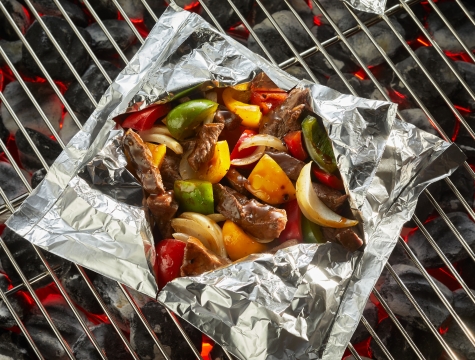
Wrapping aluminum foil grill packets and cooking on the grill
Foil packet dinners add simplicity to your outdoor grilling experience. Imagine savoring your favorite seasonings and sauces sealed in a wrapped Reynolds Wrap® Non-Stick Grill Foil — locking in all the delightful flavors. From Lemon Chicken with Fingerling Potatoes Foil Packets to Foil Packet Peach Crisp, get ready to dive into these easy and delicious recipes your family won’t be able to resist.
You can’t go wrong using aluminum foil to grill pizza, meats, veggies, and more. Grilling with aluminum foil sheets allows that smoky, delicious taste to infuse everything you cook while keeping your food from falling through the grates and protecting it from sticking. Explore all our delectable packet meals and grilled recipes to find your next favorite meal.
FREQUENTLY ASKED QUESTIONS ABOUT ALUMINUM FOIL
CAN YOU USE ALUMINUM FOIL IN THE MICROWAVE?
CAN ALUMINUM FOIL GO IN THE OVEN?
IS COOKING ON ALUMINUM FOIL SAFE?
Aluminum foil is a reliable and safe method for storing and cooking food. Research shows only minimal amounts of aluminum transfer from cookware and foil into food. View Is It Safe to Cook with Aluminum Foil for more details.
DOES ALUMINUM FOIL BURN?
CAN YOU BAKE ON ALUMINUM FOIL?
Foil is a versatile material used for lining baking pans and cookie sheets. Love soft, fudgy brownies with a crunchy, chewy crust? How about browned, crispy cookie bottoms? Bake your brownies and cookies in pans lined with aluminum foil. Aluminum foil’s heat-conducting properties result in browner and crispier bottoms to your baked goods. If you prefer softer cookie bottoms, use Reynolds Kitchens® Parchment Paper instead.